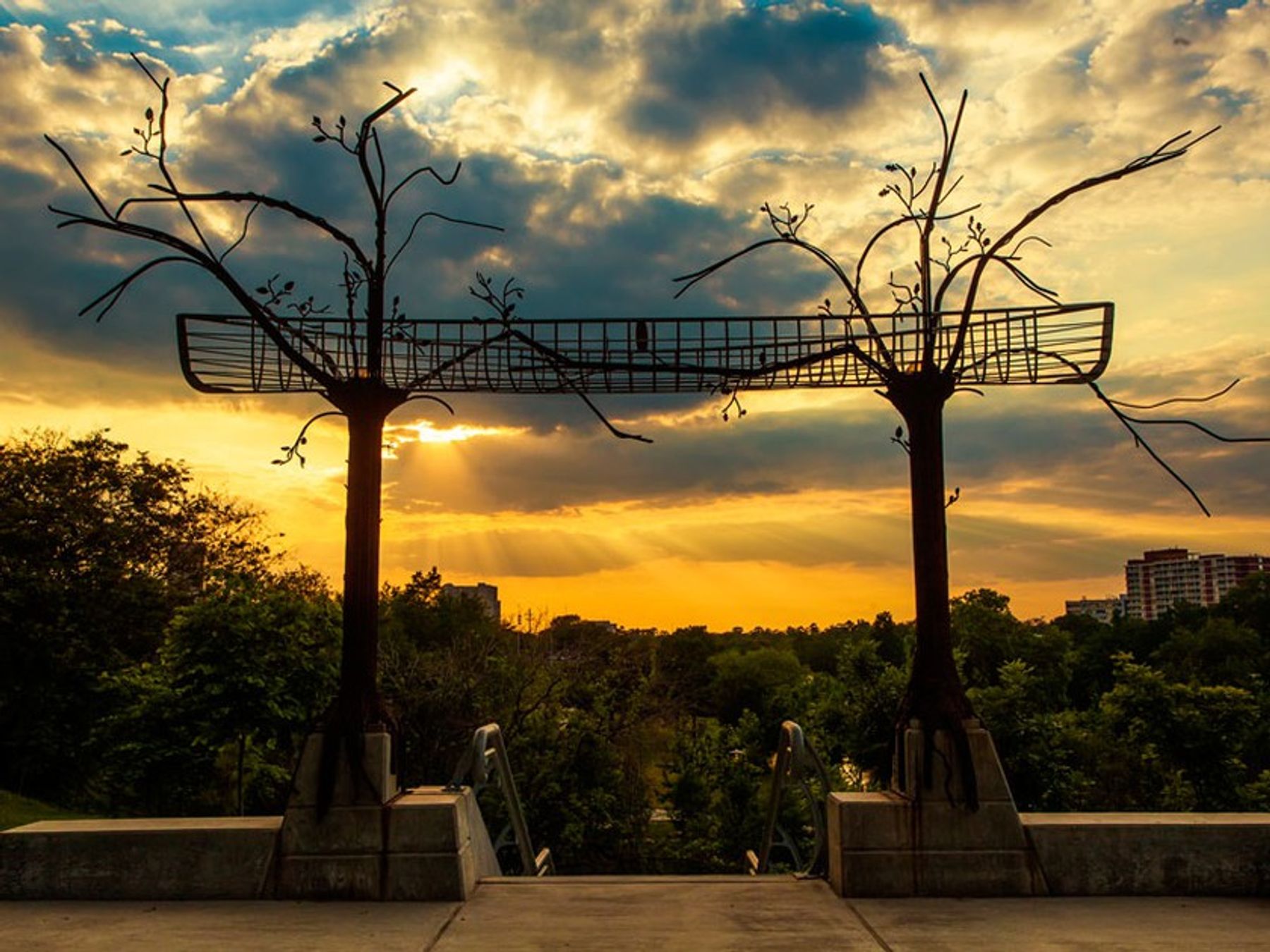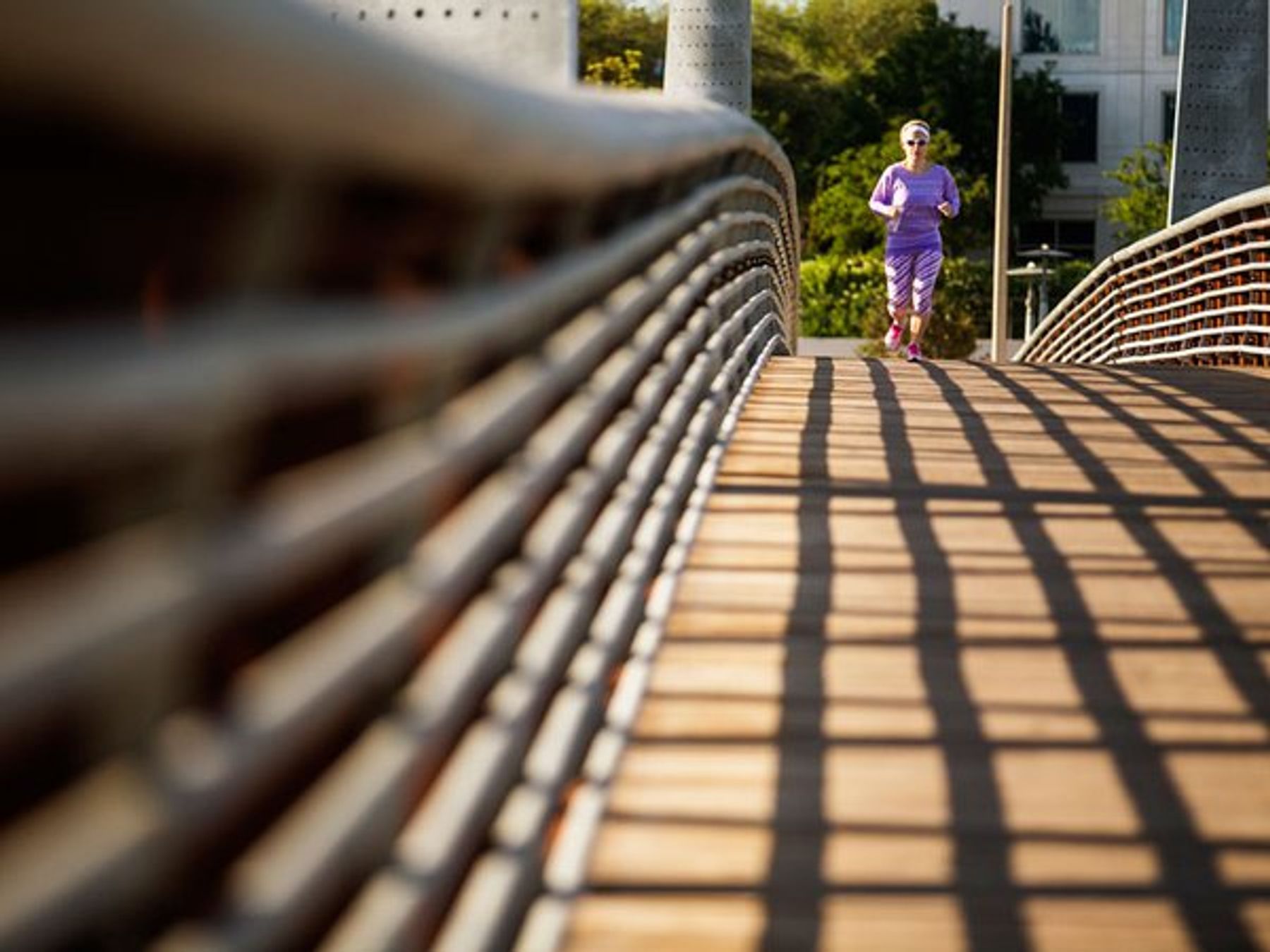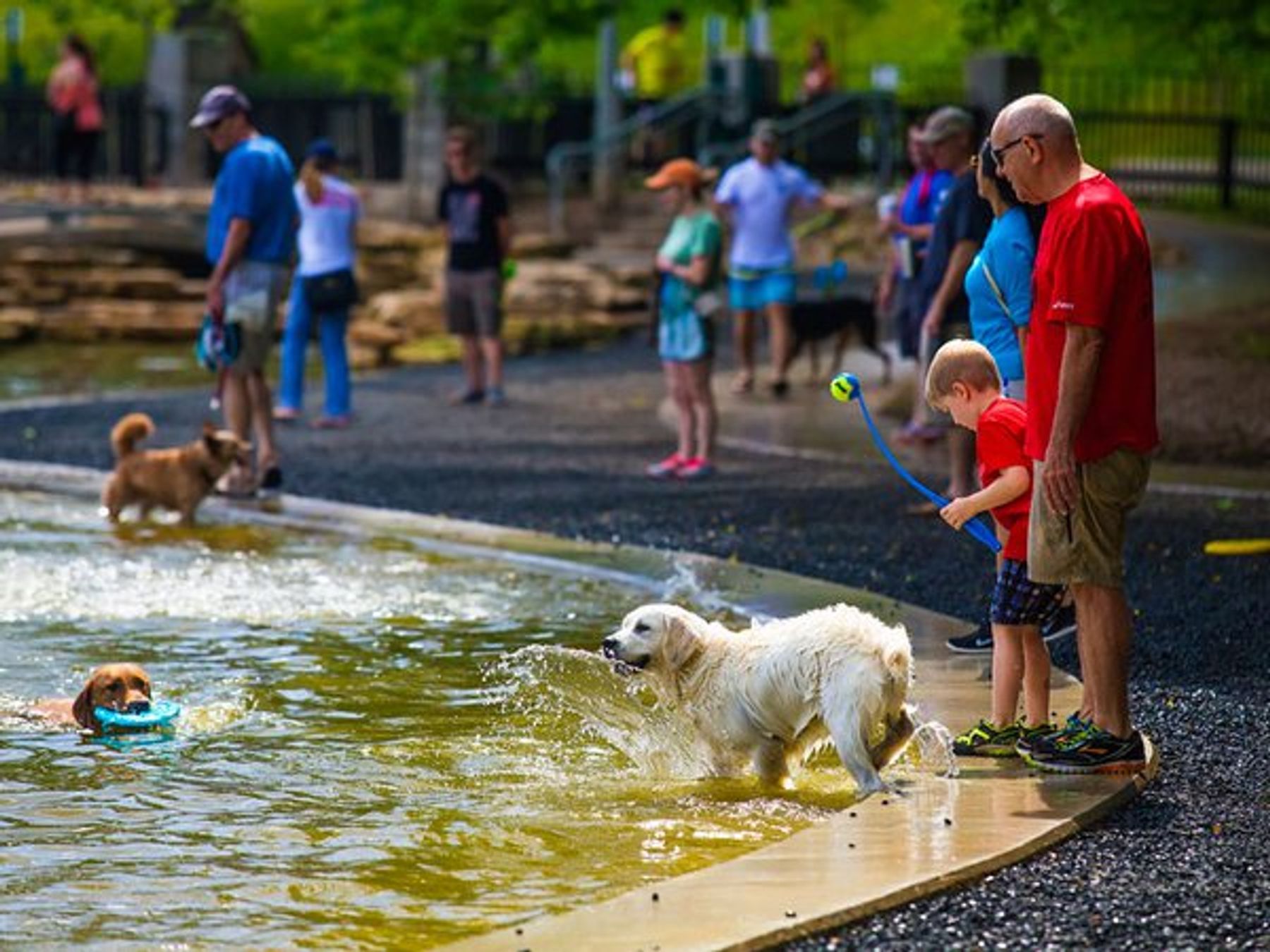Development • Historical • Things to Do
Bridging the Bayou
Buffalo Bayou Partnership's labor of love for Houston’s original landmark highlights our need to commune with nature
Buffalo Bayou is the ultimate symbol of Houston. Spanning some 53 miles across the vast Houston area – from Katy to the Ship Channel – the bayou has had its ups and downs, its moments of stunning beauty and its messier, muddier times. And lately, Buffalo Bayou has come to exemplify the livable city – right here in Houston.
Buffalo Bayou inspired the Allen Brothers’ 1836 ad campaign to establish their “great interior commercial emporium of Texas.” Allen’s Landing, at the south bank of the bayou just east of Main Street, marks the spot that Augustus C. and John Kirby Allen proclaimed the birthplace of the city, which they aptly named for the war hero who lead Texas to victory at the Battle of San Jacinto, General Sam Houston.
With a similarly bold vision, the Buffalo Bayou Partnership was founded 150 years later in 1986 with the determined mission to preserve ecologies and manage the bayou to benefit both the infrastructure and the residents of the city. Consulting with a team of experts, engineers and designers, led by distinguished urban designer Jane Thompson of Boston-based Thompson Design Group, the Buffalo Bayou Partnership presented its ambitious Buffalo Bayou and Beyond master plan in 2002.
The plan’s central drive seeks a balance of conservation and development and asserts that “nature is not a decorative element, but an essential system.” And year-by-year, for the past 13 years, the partnership has worked diligently to make that plan a reality.
You’ve seen the results on the front page of most every article about Houston over the past two years. The convergence of the city’s elevated profile and the recent upgrades to Buffalo Bayou Park have plastered images of the picturesque bayou park as the welcome mat for the great gleaming skyline across all media.
The image of the skyline paired with the bayou scene has become our Golden Gate Bridge, our Eiffel Tower – iconic and evocative of all that the city has to offer. For locals, the improved bayou offers a greatly enhanced quality of life, with easy access to nature appreciation, exercise trials and the simple pleasure of looking at water.
Overarching Themes
Bridges, branches and blue lights provide unifying visuals to the overall parkscape along Buffalo Bayou. The sculptural, functional bridges, with their triangular trusses of COR-TEN steel (also known as weathering steel) and pylons of rolled steel galvanized in zinc serve as structural billboards that literally funnel people into the park.
Besides the flowing water current, another current that runs throughout the Buffalo Bayou Park project is the distinctive blue lighting, which has been extended from the Sabine Promenade all the way to Shepherd Drive. The lighting elements, designed by L’Observatoire and Stephen Korns, illuminate the bayou and its pathways from now-iconic lampposts and the undersides of bridges.
To restore significant portions of park to its natural state and ease erosion, SWA Group planted 14,000 trees throughout the multiyear park improvement project, along with vast numbers of shrubs, grasses and wildflowers. Plants were selected for their natural durability and tolerance for Houston weather conditions, such as hot, dry summers and seasonal heavy rains. Trees planted include more than 10 varieties of oaks, plus, sycamores, magnolias and loblolly pines, and ornamental trees, such as Eastern redbud, Mexican plum and Southern wax myrtle. A few of the eye-catching shrubs and groundcovers include Gulf Coast muhly grass, turk’s cap, American beautyberry, scarlet sage and trailing lantana. Firms Reed-Hilderbrand of Cambridge, Mass. and Texas-based Page also contributed to the landscape effort.
Near Jackson Hill Bridge & Waugh Bridge
West of Waugh Drive, restored wetlands and a private event space offer key attractions for social butterflies and actual butterflies. Lost Lake features a restored pond that previously existed next to the bayou (near the intersection of Dunlavy Street and Allen Parkway), while The Dunlavy provides a 3800-square-foot event facility, as well as a Grab and Go concept providing counter-service breakfast and lunch seven days a week. The surrounding gardens, which accommodate Beth Yeshurun Cemetery, feature a stream garden, a cascade water feature, which leads to the McGovern Lawn. The Dunlavy site also includes a park visitor center, canoe/kayak rental facility and 80 parking spaces.
Waugh Bridge itself is the site of a natural, nocturnal phenomenon as the Waugh Bridge Bat Colony awakens at sunset. The curious gather here to watch as the famous colony of Mexican free-tailed bats takes flight, a spectacle happens every night around dusk. According to the City of Houston Parks Department, the colony of an estimated 250,000 bats could consume nearly 2.5 tons of insects each night. Who doesn’t love watching 250,000 insect eaters setting out for a night of feasting? Access: By car, park near Wortham Fountain or find parking near the American General complex across Allen Parkway. On foot or bike, use the Jackson Hill Bridge and take the trail to the Waugh Bridge.
The simple beauty of the dandelion-shaped spray of the Wortham Fountain has made it a longtime favorite of Houstonians and visitors. Local architecture buffs will appreciate that Rice University architecture professor William T. Cannady designed the fountain, which was completed in 1978. Local canines often show their admiration with a refreshing dip in the fountain.
Tails have been wagging all over town since the much-anticipated Johnny Steele Dog Park opened earlier this year, complete with fountains, ponds, shade structures and separate zones for large and small dogs. The genuine, real-deal dog park is named for longtime local landscaper Johnny Steele. Access: By car, park along Allen Parkway near Montrose Boulevard, or at the American General Complex on weekends. For pedestrians, the dog park is easily accessible via the Rosemont Bridge.
Near Montrose Bridge & Rosemont Bridge
The expansive and highly visible Rosemont Bridge, with its two-pronged approach to the trails, serves as a beacon pointing to the pleasurable pursuits that await along Buffalo Bayou. The “high road” branch ushers pedestrians and cyclists from the north side of Memorial Drive over to the south bank of the bayou, while the “low road” portion traverses the two banks of the bayou.
For some nature appreciation, retreat from the bustling city with a walk in the wooded Green Tree Nature Trail, a truly hidden gem that takes a bit of effort to find. This peaceful patch is located off the southeast segment of the Memorial Drive/Waugh cloverleaf interchange. It lies on the north bank of the bayou, in a sense, “just across the street” (Memorial Drive) from Spotts Park. Pedestrians can venture off the concrete trails on the north bank of the bayou to explore this mini-nature preserve via its meandering gravel/mulch trail to admire native trees and plants and observe the squirrels, rabbits and birds who enjoy this habitat on a regular basis. Access: By foot, seek out this nature trail via the lower leg of the Rosemont Bridge.
Juame Plensa’s Tolerance Sculptures, prominently positioned near the corner of Allen Parkway and Montrose, are both large in size, yet unintimidating in stance. Plensa’s seven majestic human figures represent the world’s seven continents and are composed of stainless steel letters of many different languages. These symbols of diversity sparkle on a sunny day and glow by night and are popular photo subjects for professionals and amateurs alike. Access: By car, find a few parking spaces at Allen Parkway and Montrose. On foot or by bike, use Rosemont Bridge.
From the north side of the bayou trail, pedestrians and cyclists can glimpse into the serene scene that was one of the first cemeteries established in the city. The 18-acre Glenwood Cemetery, founded in 1871, is one of the most peaceful pockets of Houston’s central core. Portions of the scenic cemetery are visible from the trails near the Police Officers Memorial, but the main entrance is on Washington Avenue via the handsome ivy-covered columns and iron gates located just east of Montrose Boulevard. See GlenwoodCemetery.org to read about the “notable interred” – a list that reads like a who’s who of Houston history, including Anson Jones, the Allen Brothers, Howard Hughes and many others.
Near Sabine Bridge & Sabine Promenade
The park within the park, Eleanor Tinsley Park serves as the home of the City’s annual 4th of July celebration and other major festivals. The 20-acre park was dedicated in 1998 in honor of the late City Councilmember and civic activist Eleanor Tinsley. Recent improvements to the generous lawns and dramatic slopes include upgraded landscaping, redesigned parking areas and a new trail connection to the Sabine Promenade. Additional features include the Nau Family Pavilion, volleyball court, Hines Meadow and formal Jane Gregory Garden. At the four corners of the Sabine Bridge, John Runnels’ stainless steel boat sculptures stretch across stairways that lead down to the bayou banks, one of which serves as the main boat launch for Buffalo Bayou Partnership’s pontoon boat tours. West of Sabine Street, Runnels’ newly installed boat sculpture combines COR-TEN steel and stainless steel for his It Wasn’t a Dream, It was a Flood. Access: located off Allen Parkway, just west of Sabine Street.
Jesus Bautista Morales’ Houston Police Officers’ Memorial features a ziggurat design of five stepped pyramids. This notable earthwork sculpture, installed in 1990, is much more accessible today with the completion of trails on both banks of the bayou and the installation of the Carruth Bridge. The improved access allows park users to interact with the memorial as Morales had intended, as a playscape and gathering spot. Access: On foot or by bike: the memorial can be reached from Eleanor Tinsley Park via the trail that crosses under Memorial Drive. By car, parking can be found at Eleanor Tinsley Park, as well as near the intersection of Sawyer Street and N. Memorial Way (a small street just north of Memorial Drive).
Another remarkable sculpture in the park is Henry Moore’s Spindle sculpture. The world-renowned Moore created the abstract cast bronze sculpture for his spindle series in 1968, originally displayed in London’s Hyde Park. Moore’s substantial bronze Spindle, added to Buffalo Bayou Park in 1979, sits atop a knoll that now features added landscaping and a stairway approach. The area makes an ideal stretching stop, complete with contemplative setting and a water fountain. Access: walk or bike from Eleanor Tinsley Park.
For more public art pondering, trek to the skeletal house structure of Passage Inachevé by artists Linnea Glatt and Francis Thompson, installed in 1990. The imagery within the framework represents issues such as human rights and freedom of expression. Access: walk or bike from Sabine Street/Water Works/Skatepark area.
Nearby, the heavily shaded Tapley Tributary serves as a snapshot of a naturally occurring tributary. Houston landscape architect Charles Tapley cultivated this natural area to highlight a bayou tributary and the typical riparian flora. In addition to the shelter of trees, this peaceful area includes a variety of blooming plants such as lilies, irises and arrowhead. The area also features granite steps and seating areas, ideal for rest and reflection. Recent improvements include a wetland area, a native Texas prairie and a small pedestrian bridge. Access: walk or bike from Sabine Street/Water Works/Skatepark area.
The generously sized Lee & Joe Jamail Skatepark features one of the largest skate cradles in the world. The 30,000-square-foot skatescape attracts novice skaters and professionals alike. A few steps from the skatepark, Matthew Geller’s shower/sculpture Open Channel Flow offers a refreshing splash of water when activated. Access: walk or bike from Sabine Street (just follow the skateboarders).
A former city water reservoir inspired the design of The Water Works complex at Sabine Street. This multi-level destination was envisioned as a major gateway to Buffalo Bayou Park. The wide-open Brown Foundation Lawn offers a grassy plateau ringed by sycamore trees, and the Hobby Family Pavilion serves as a performance stage and event venue. Closer to Sabine Street, the Wortham Insurance Visitor Center features restrooms, day rentals for bikes provided by Bike Barn, and a parking area, complete with food trucks.
The Cistern is a former drinking water reservoir built in 1926 for the City of Houston. As one of the city’s early underground reservoirs, it supported the municipal water system’s goals of fire suppression (water pressure) and drinking water storage. After operating for decades, an irreparable leak was discovered and after a few years, the reservoir was decommissioned in 2007. Recognizing the historical and architectural significance of the highly unusual space, Buffalo Bayou Partnership restored and repurposed the Cistern into a magnificent public space to house an ambitious program of changing art installations.
Between the skatepark and the bayou, the Nature Play Area features a new tri-level tree house/boat-inspired deck encouraging children to discover the wonders of nature through play. The surrounding area includes numerous boulders for climbing and scrambling over, a rolling lawn, a stream and waterfall, climbing logs and stones and a 33-foot slide. Parents will appreciate the access to parking, restrooms, park staff and the option to rent the adjacent picnic pavilion for events/birthdays. Access: find parking at The Water Works, along Sabine Street or in Lot H.
Opened in 2006, the Sabine Promenade (located between Sabine Street and the Downtown Aquarium) offers a pleasant departure from the interstate that spans above. The freeway structure serendipitously provides shade and shelter from rain, while the gentle curves of the bayou and its banks offer pleasing scenery, winding trails and public art. As the sun sets, the majestic blue lighting designed by L’Observatoire and Stephen Korns illuminate the bayou and its pathways via lampposts and the undersides of bridges with the hue of the lighting corresponding with the phases of the moon. Access: From downtown, this area is easily reached from behind the Hobby Center (parking available there).
Sam Houston Park sits just a few steps off the Sabine Promenade and dates back to 1899. Today, eight historic homes and one historic church represent ways of life in Houston from the mid 1800s to 1905. The historic structures have been lovingly preserved and maintained by The Heritage Society.
From Sesquicentennial Park to Allen’s Landing
Mel Chin’s now-iconic Seven Wonders pillars often attract visitors to Sesquicentennial Park, dedicated in honor of Houston’s 150th birthday, shortly after the founding of the Buffalo Bayou Partnership. The seven 70-foot structures, installed in 1998, flank the back of the Wortham Center and represent the themes of agriculture, energy, manufacturing, medicine, philanthropy, technology and transportation. The columns are composed of 150 individual children's drawings, etched into stainless steel plates.
From the Wortham Center’s Fish Plaza, a brick gazebo and cascading waterfall lead pedestrians and the occasional Segway tour to Sesquicentennial Park’s handsome pathway that run along the water’s edge and feature an expansive, formal spindle railing. Additional sculptures include Dean Ruck’s interactive Big Bubble, and bronze statues of former Secretary of State James Baker III and former President George H.W. Bush by Chas Fagan. Access: Approach from Wortham Center area; use Theater District parking. Continuing along the bayou and crossing under the Congress Avenue Bridge offers a spectacular vantage point for viewing the University of Houston-Downtown main building. At the moment, the north bank trail is the only option, but the TIGER trail extensions are set for completion by July 2015, finally connecting the Buffalo Bayou trails to those along White Oak Bayou into the Heights area. The new trails on both banks of the bayou will provide access to Allen’s Landing and the renovated Sunset Coffee Building, expected to open early next year.
Allen’s Landing, at the confluence of Buffalo and White Oak Bayous, has been described as Houston’s Plymouth Rock, the place where the Allen Brothers launched our now world-class city. The historic Sunset Coffee Building was built in 1910 as an annex to the 1880’s W. D. Cleveland & Son’s wholesale grocer supply building. With design expertise of the architects Lake | Flato, BNIM and landscape architect SWA Group, the Sunset Coffee Building emerges this summer as dynamic recreational and cultural center. The building will house BBP’s offices, a rooftop terrace, a paddle craft/bike rental facility (supported by Bike Barn), and an outdoor plaza. Park users can rent canoes/kayaks at Lost Lake and paddle or float downstream and return their boats at Allen’s Landing. Access: Find parking near Fannin at Commerce; BCycle station at Main and Commerce.
Mentioned in this Post
Buffalo Bayou Park
One Main St
Buffalo Bayou Partnership
1019 Commerce St


